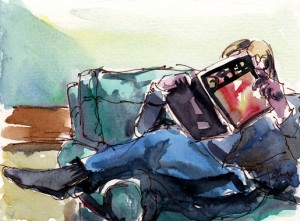 There are many things to celebrate and some to lament regarding the emerging digital book technology and the vanishing printed book art. One thing I’m beginning to look upon nostalgically is the demise of dust jackets. The cliché, ‘don’t judge a book by its cover’ is only partly true part of the time.
There are many things to celebrate and some to lament regarding the emerging digital book technology and the vanishing printed book art. One thing I’m beginning to look upon nostalgically is the demise of dust jackets. The cliché, ‘don’t judge a book by its cover’ is only partly true part of the time.
Publishers of print often print first runs of their promising titles as a hardback edition. The book itself is sandwiched within numerous materials. It’s anatomy was so unique as to require specialists of various stripes to properly fit the cover with the content.
Print books compete for attention on bookstore shelves among other titles. Therefore publishers usually pay special attention to the covers. The dust jacket provided the flexibility to afford a designer a creative palate with an open imagination. Designers could go wild with four-color printing with additional spot colors. They can mix sheens of gloss and matt varnishes or die cut shapes from the cover. They could foil stamp over embossed letters, or even glue other materials to the dust jacket. Designers can pick materials such as case fabrics or even leather for the dust jacket. The tactile quality of an elaborately designed dust jacket could certainly add an extra dimension to the reading experience.
Some designers have even eclipsed the authors in their notoriety. One of my favorite designers, whose artwork in known more in industrial and film parlors than book cover design is Syd Mead. While he is best known for his futurist and science designs, most genres, i.e., history, romance novels, fantasy and others have their ‘star’ dust jacket artists. I’ve caught myself buying a book because of its cover, not knowing if the book is worth reading. Yet I knew if it was a dust jacket designed by one of my favorite artists, I was seldom disappointed with the content.
Still, I embrace e-books. Many authors who are throwing plain wrappers on their digital books are doing themselves a disservice. Just as there was competition on physical bookshelves, so there is on the digital shelves. This will create opportunities for artists migrating from the dust cover to the glass cover books.
For now, I must be content to wrap my books in faux leather iPad and fabric Kindle covers. Yet I imagine there is a digital dust jacket equivalent in my future.
What would you miss in digital books that are found in print books?
